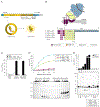A high-throughput cell-based screening method for Zika virus protease inhibitor discovery
- PMID: 38796112
- PMCID: PMC12005090
- DOI: 10.1016/j.slasd.2024.100164
A high-throughput cell-based screening method for Zika virus protease inhibitor discovery
Abstract
Zika virus (ZIKV) continues to pose a significant global public health threat, with recurring regional outbreaks and potential for pandemic spread. Despite often being asymptomatic, ZIKV infections can have severe consequences, including neurological disorders and congenital abnormalities. Unfortunately, there are currently no approved vaccines or antiviral drugs for the prevention or treatment of ZIKV. One promising target for drug development is the ZIKV NS2B-NS3 protease due to its crucial role in the virus life cycle. In this study, we established a cell-based ZIKV protease inhibition assay designed for high-throughput screening (HTS). Our assay relies on the ZIKV protease's ability to cleave a cyclised firefly luciferase fused to a natural cleavage sequence between NS2B and NS3 protease within living cells. We evaluated the performance of our assay in HTS setting using the pharmacologic controls (JNJ-40418677 and MK-591) and by screening a Library of Pharmacologically Active Compounds (LOPAC). The results confirmed the feasibility of our assay for compound library screening to identify potential ZIKV protease inhibitors.
Keywords: Cell-based assay; HTS; Protease inhibitors; Zika virus.
Copyright © 2024. Published by Elsevier Inc.
Conflict of interest statement
Declaration of competing interest The authors declare that they have no known competing financial interests or personal relationships that could have appeared to influence the work reported in this paper.
Figures



Similar articles
-
Cleavage of SQSTM1/p62 by the Zika virus protease NS2B3 prevents autophagic degradation of viral NS3 and NS5 proteins.Autophagy. 2024 Dec;20(12):2769-2784. doi: 10.1080/15548627.2024.2390810. Epub 2024 Aug 17. Autophagy. 2024. PMID: 39128850 Free PMC article.
-
Eltrombopag, an FDA-approved drug, inhibits dengue virus type 2 by targeting NS2B-NS3 protease.Virol Sin. 2025 Jun;40(3):439-450. doi: 10.1016/j.virs.2025.05.009. Epub 2025 May 28. Virol Sin. 2025. PMID: 40447137 Free PMC article.
-
Cellular NONO protein binds to the flavivirus replication complex and promotes positive-strand RNA synthesis.J Virol. 2024 Dec 17;98(12):e0029724. doi: 10.1128/jvi.00297-24. Epub 2024 Nov 5. J Virol. 2024. PMID: 39499073 Free PMC article.
-
The Inhibition of NS2B/NS3 Protease: A New Therapeutic Opportunity to Treat Dengue and Zika Virus Infection.Int J Mol Sci. 2024 Apr 16;25(8):4376. doi: 10.3390/ijms25084376. Int J Mol Sci. 2024. PMID: 38673962 Free PMC article. Review.
-
NS2B-NS3 protease inhibitors as promising compounds in the development of antivirals against Zika virus: A systematic review.J Med Virol. 2022 Feb;94(2):442-453. doi: 10.1002/jmv.27386. Epub 2021 Oct 20. J Med Virol. 2022. PMID: 34636434
Cited by
-
Towards a Survival-Based Cellular Assay for the Selection of Protease Inhibitors in Escherichia coli.BioTech (Basel). 2025 Mar 7;14(1):16. doi: 10.3390/biotech14010016. BioTech (Basel). 2025. PMID: 40227283 Free PMC article.
-
SARS-CoV-2 Mpro inhibitor identification using a cellular gain-of-signal assay for high-throughput screening.SLAS Discov. 2024 Sep;29(6):100181. doi: 10.1016/j.slasd.2024.100181. Epub 2024 Aug 22. SLAS Discov. 2024. PMID: 39173830 Free PMC article.
References
-
- Mlakar J, Korva M, Tul N, Popovic M, Poljsak-Prijatelj M, Mraz J, Kolenc M, Resman Rus K, Vesnaver Vipotnik T, Fabjan Vodusek V, Vizjak A, Pizem J, Petrovec M, Avsic Zupanc T. Zika virus associated with microcephaly. N Engl J Med 2016;374:951–8. - PubMed
-
- Carod-Artal FJ. Neurological complications of Zika virus infection. Expert Rev Anti Infect Ther 2018;16:399–410. - PubMed
-
- Pielnaa P, Al-Saadawe M, Saro A, Dama MF, Zhou M, Huang Y, Huang J, Xia Z. Zika virus-spread, epidemiology, genome, transmission cycle, clinical manifestation, associated challenges, vaccine and antiviral drug development. Virology 2020;543:34–42. - PubMed
-
- Kang C, Keller TH, Luo D. Zika virus protease: an antiviral drug target. Trends Microbiol 2017;25:797–808. - PubMed
Publication types
MeSH terms
Substances
Grants and funding
LinkOut - more resources
Full Text Sources
Medical
Research Materials

